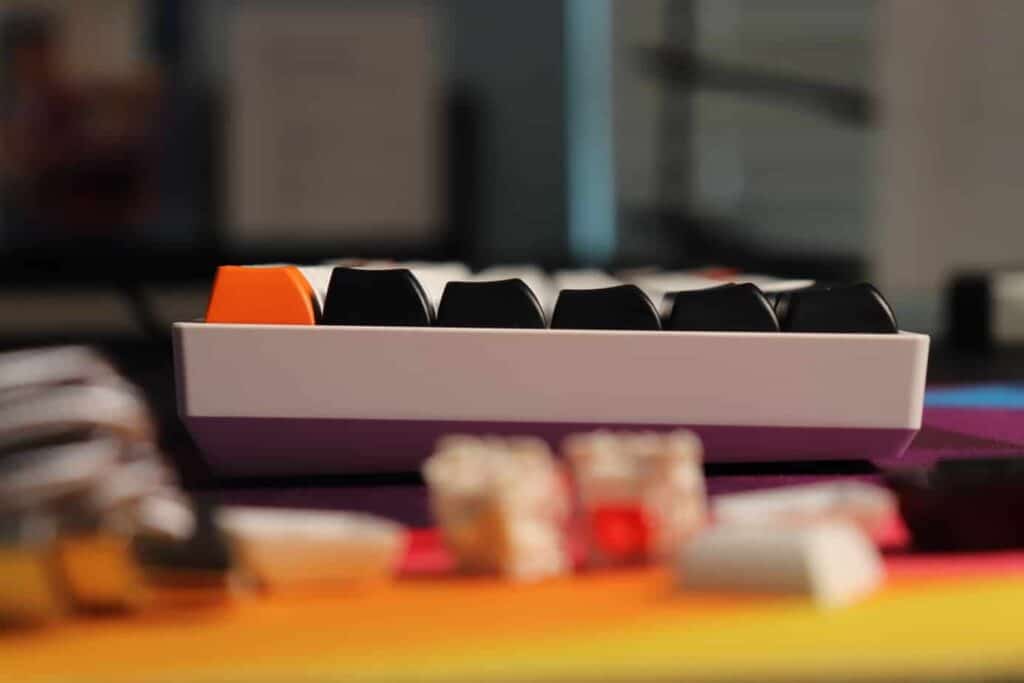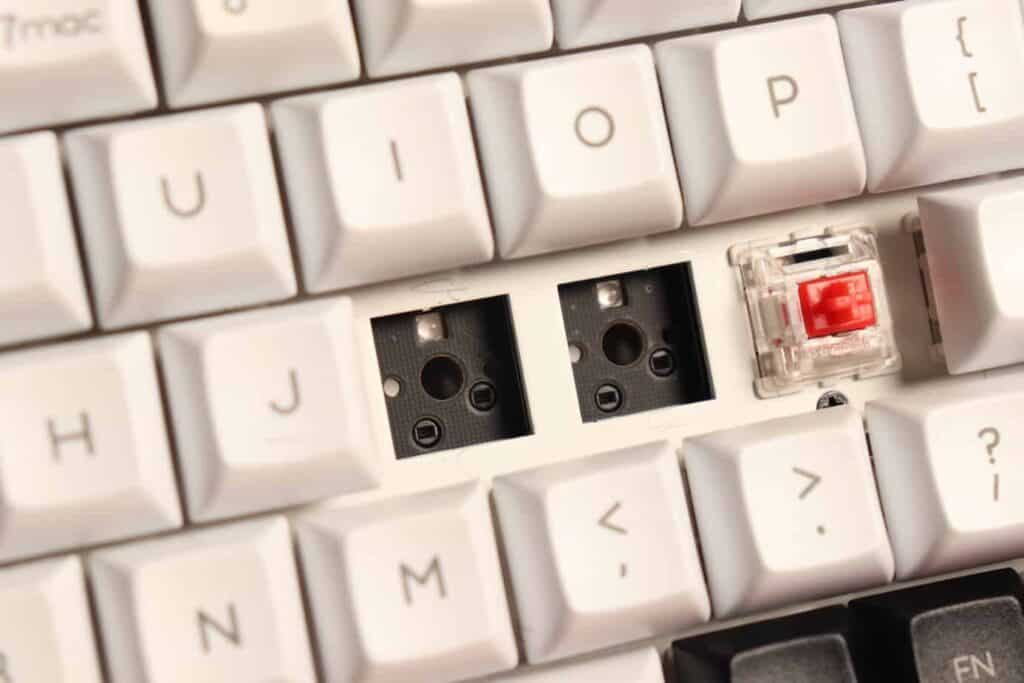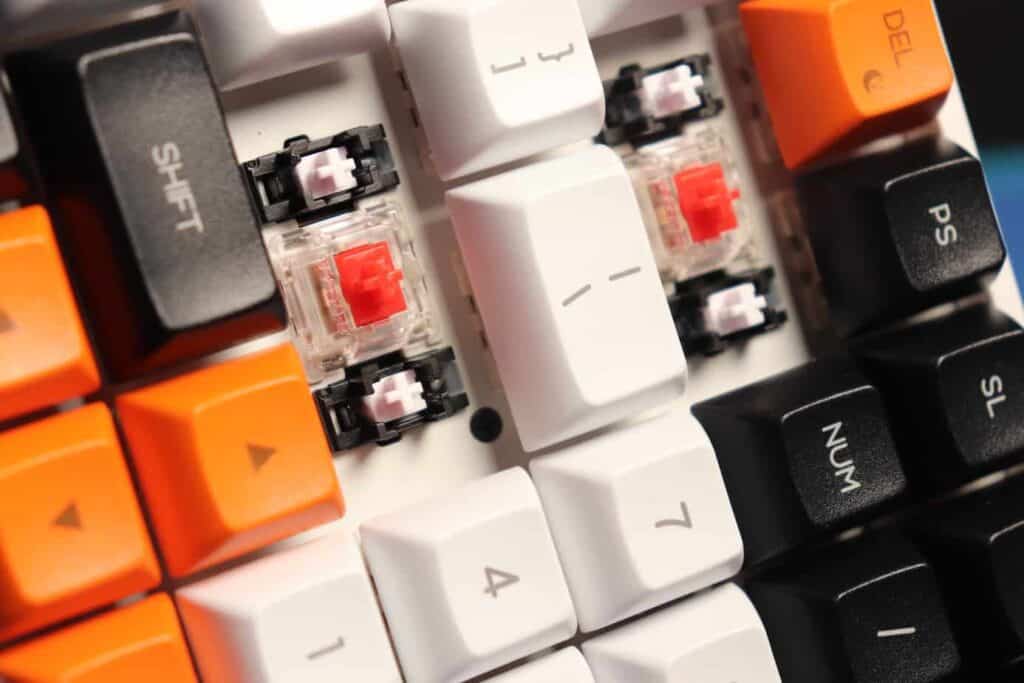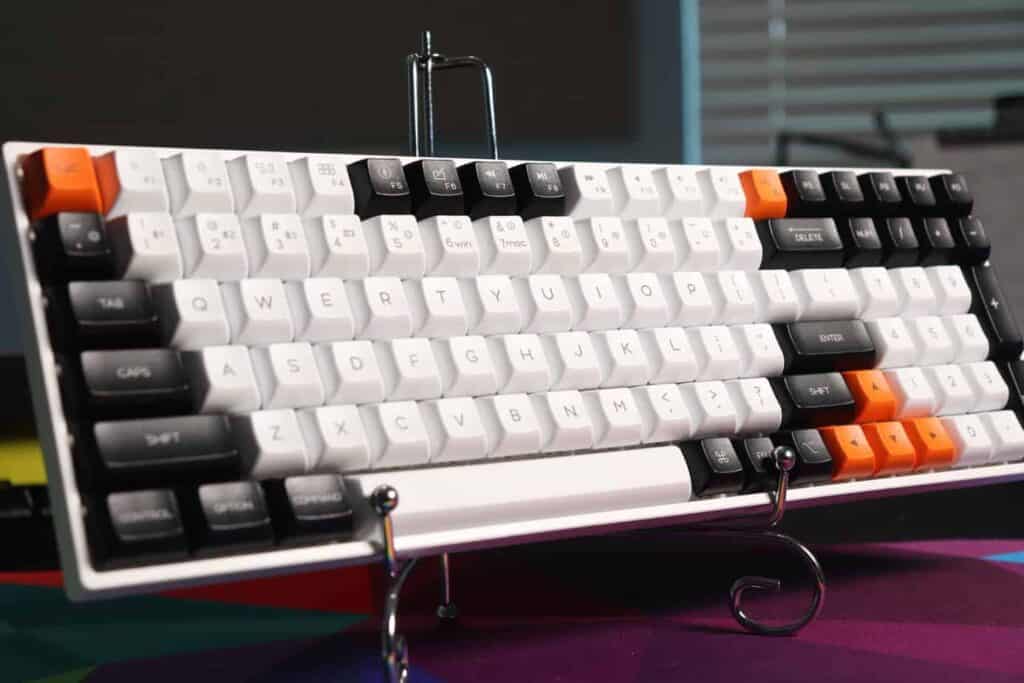Epomaker has been experimenting widely with different mechanical keyboard layouts. With their newest launch, they’ve decided to make a 96% hot-swappable and Bluetooth mechanical keyboard.
Alongside this, there is an option to have the numberpad be on the left side, also known as the southpaw version. We’ll talk about the differences between the regular and southpaw ones down below.
This review will cover all of the unique features of the board as well as look at the switches, keycaps, and stabilizers of the Epomaker GK96.
The Verdict

The Epomaker GK96 is perfect for people who find themselves using the number pad often but want a compact layout. Perhaps due to a small desk or maybe you use your mechanical keyboard for work and play.
It has a ton of upgraded features from the other Epomaker boards and these warrant some discussion.
The GK96 comes in several different options:
- Regular with PBT dye-sub keycaps where the number pad is on the right with arrow keys (black or white case)
- Southpaw with PBT dye-sub where the number pad is on the left and no arrow keys (black case)
- Regular with ABS shine-through keycaps with number pad on the right (black or white case)
If you don’t use the number pad often, then perhaps an even smaller layout such as a 65% or a 75% mechanical keyboard will benefit you more.
To find out more about the Epomaker GK96 Kickstarter launch, check out their landing page.
In The Box

Inside the box, there are a bunch of different accessories to accommodate for all of its features.
- Keyboard – More detail on this down below.
- Additional Gateron switch sampler kit – 7 different Gateron switches (clear, yellow, red, brown, blue, black, and box silver) for you to try out before you purchase your next board.
- Additional Windows keycaps – The keyboard comes with Mac keycaps stock on it, so Windows additional ones are available for all modifiers (5 keycaps total).
- Combined switch and keycap puller – On one end, it’s a wire keycap puller. On the opposite end, it’s a switch puller. Quite convenient.
- USB-C braided cable – It’s silver with silver and black plastic end pieces and looks super stylish.
- Manual – The manual attached is really long. It features the different models and how to use them because there are different series. Refer to the manual for secondary functions such as how to modify RGB lighting and change sleep mode.
Build Quality and Layout

The Epomaker GK96 is a 96% board. This means it takes a full-size keyboard, ditches a few of the keys (home, insert, end, etc.), and then smushes it all together. See our full size guide for more information.
The case design of this board is much better than Epomaker’s other designs. On the back, there are two kick-up feet with two angles each. Finally, they decide to add some angle adjustment.
There are also 5 rubber feet on the back, so no slipping. If you use a cloth desk mat, there won’t be any slipping anyways.
The case is all plastic and comes in either black or white, depending on the color way you pick. It does have a natural incline to it.
The case encompasses the switches, so it doesn’t have a floating keycap design.
The plate is white and reflects RGB off quite nicely. There is no flex to the keyboard when manual force is applied. No creaking either.
At the top of the board, you do get a dedicated Delete key right over Backspace.
The number pad is completely functional with all of the mathematical operators, and using the arrows to move through the tables (if you do that) is super easy as well.
For the southpaw version, there are no arrow keys. It’s basically a 60% board with a complete number pad attached on the left side. You can still navigate through tables and number entry tasks by using your mouse, but this looks to be a bit inconvenient.
The Keycaps

The keycaps offered are either ABS shine-through or PBT dye-sub. The review sample we have has their newest profile, GK1.
This profile is a sculpted profile with round keycaps. It varies from row to row, which is an improvement from the GSA uniform profile keycaps that are on the other Epomaker boards.
However, they still require some time to get used to with how far the tops of the caps are from each other and the roundedness of the tops. But once you get used to it, it’s really easy to use.
The ABS keycaps are offered in the same profiles, but they have shine-through with stenographic legends. This means that closed letters such as O and P have separations in them.
The keycaps have sub legends on the majority of their keycaps. There are still some functions that are on the manual only, and you need to read the manual for these and then memorize them.
However, it’s easy to see what the function row does as well as the number row’s secondary functions.
The Switches

The GK96 is available with hot-swappable Gateron switches. The SK96 is available with hot-swappable Gateron optical switches.
There are many switch types available, but they have not officially announced this yet. See their landing page for more information.
My best guess is that they’ll have the keyboard available with the switches that they included in their switch testing kit:
- Red
- Blue
- Brown
- Yellow
- Clear
- Black
- Box Silver
But, that may just be a sample. We shall have to wait and see for the official switch offerings.
The hot-swap sockets are 5-pin, so you can use Cherry, Kailh, Gateron, ZealPC, and other mechanical switches as well.
For more information on the availble Gateron switches, see this guide here.
For some ideas on what switches to put on your board next, check out these recommended lists:
- Best Switches for Gaming
- Best Switches for Typing
- Best Clicky Switches
- Best Tactile Switches
- Best Linear Switches
The hot-swap sockets are 5-pin, and the RGBs are on the top of the switch. As a result, we get north-facing switches, which may result in some clearance issues with GMK keycaps.
The Stabilizers

The stabilizers on this board actually blew me away quite a bit. Many of the Epomaker boards have lubed stabilizers. However, they’re always done hastily and messily.
In the GK96, we see a significant difference here. The lube is adequately and neatly applied on the stabilizer wires.
This means that the stabilizers actually show the effects of the factory lube. As a result, they are much more quiet, show minimal rattle. The only key that sounds sort of loud is the spacebar.
With the keyboard being hot-swappable, of course we recommend that you clip your stabilizers to reduce the noise even further.
Here is a guide on how to do that with pictures and step-by-step instructions.
They are plate-mounted Cherry-style stabilizers with a white stem and black stabilizer housings. Quite a unique look.
The spacebar may benefit from foam within the bar as well. It does sound quite hollow, combined with the plastic case design.
The Features
The GK96 has a ton of additional features.
Bluetooth Connectivity
The GK96 has Bluetooth 5.1, which has good range and latency. It also comes with a 4000 mAh battery, which will last you more than a day of typing and gaming.
Having Bluetooth means less clutter on your desk, which is nice for your clean battlestation.
The board does need to get charged every once in awhile, or you can permanently connect it to your computer via a USB-C cable.
The cable connects on the left top side of the board and looks quite clean. The hole can also fit other custom cables as well.
To turn the board on/off, there is no slider anywhere. Actually, to do it, you hold FN and the tilde key.
Then to connect to devices, you hold FN and 1/2/3 to connect to difference devices.
To see how much battery is left, you hold FN and 4. To figure out what each level means, consult the manual.
RGB Lighting
The GK96 has on-board effects that can be cycled through. Additionally, you can download the software to program your own RGB profiles.
Mac and Windows Compatibility
It’s super easy switching between Mac and Windows by holding FN and 6/7 for either operating system.
The function row matches with the function row on Mac computers, which is convenient because you don’t have to memorize new shortcuts.
Alternative: Keychron K4

The GK96 is a direct competitor to the Keychron K4, which has many of the same features as the GK96:
- Mac/Windows compatibility
- RGB lighting
- ABS shine-through keycaps
- Bluetooth connecitivity
However, the Keychron K4 is not hot-swappable and has a very tall case design.
There are benefits to each keyboard, and it’s up to you to determine which one you prefer more.
Conclusion

The GK96 is unique and one-of-a-kind. There is no other board with all of its features currently on the market.
There is the option of having a number pad on the left side, which is extremely convenient for productivity in the workplace but also for gaming.
The new profile is easy to learn, and the board is even hot-swappable! The best part is that the case design now has adjustable kickstands, and the stabilizers are lubed properly.
This board is perfect for you if you find you absolutely need a number pad, but you also want a more compact layout. Whether you have a small desk or game, this board is great.
Check out the Epomaker landing page for more information on the GK96.
